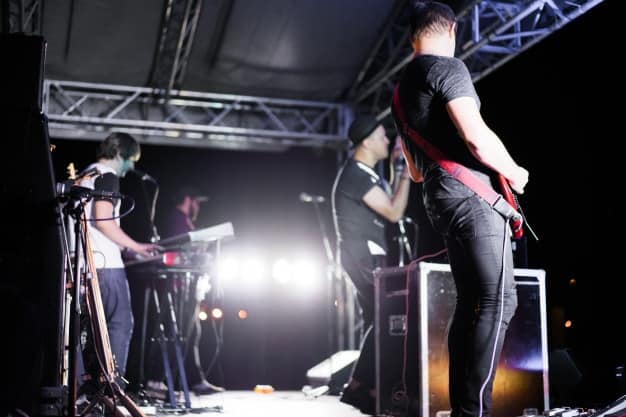Imagine the following setting.
You go out with your friends and family to see your favorite band.
When the show starts, you notice the guitarist is playing with an appalling guitar. You love that instrument!
Three songs after the show began, the guitar player changes that guitar for another one.
Three songs again, and he does the same.
Then he does it again, and again, and again.
What the hell?
Why does he have to switch guitar every other song?
Why not keep the original anyway?
Is he showing off or what?
Truth is, guitarists switch guitars for many reasons. Some guitars sound different than others and fit better on specific songs. Others are a replacement in case technical issues arise. They too change because of looks and theatrical performance.
The above, however, is merely the tip of the iceberg.
If you want to understand in more detail the how’s and the why’s, then keep on reading this article!
Not all guitars sound the same
The type of guitar you use defines, in part, the sound of a song.
Some bands combine genres instead of sticking to one sound.
In those cases, another guitar is more than enough to suit a song.
After all, a Les Paul won’t provide the same sound as an SG, and a Stratocaster is not alike a Telecaster.
But even if both guitars are of the same model, they’ll still sound different.
The reason for this is that the wood that was used for their construction may come from different trees.
This also influences the sound.
Although such details are small and may pass unnoticed to the common ear, the one performing KNOWS about them.
For some, it is going to be impossible not to switch to a certain guitar on a certain song.
Not all guitars play the same
Certain songs require changing guitars for proper performance.
Some songs, for instance, are played with 12-string guitars, or even double-necked guitars.
Others need the use of a slide on the fretting hand, so it is better to switch to a guitar with higher string action.
It is possible too, that guitarists change for the sake of how it feels.
Some guitars are lighter than others. In the end, weight also affects the final results of a performance.
If guitars can sound differently, then they can also play differently.
Not all guitars look the same
Whether you like it or not, music involves the eyes too.
Live performances are a form of art.
They are a way in which musicians can express themselves.
Some bands enjoy exhibiting extravagant clothes and costumes. Others shock the audience with astonishing acts.
Guitars are not out of the equation.
They look beautiful and suit the atmosphere a band tries to portray.
Just think about how iconic some instruments are to the world of music.
Gene Simmons’ Axe Bass; Zakk Wylde’s Gibson Les Paul Custom; Eddie Van Halen’s Frankenstrat.
All of them are part of the show too.
Players sometimes use different tunings
Different bands tend to play with different tunings.
The tuning setting of a guitar is relevant for the overall sound of any band.
Picture it this way.
You have a guitar that needs to be tuned.
You’ll most probably tune it to E Standard, which is the typical tuning for string instruments.
This means that if you play air notes (notes that do not require using the fretting hand), each string will produce a specific note.
For a regular six-string guitar on Standard tuning, the notes are EADGBE from the sixth to the first string.
Now, some musicians prefer experimenting with other tunings because they get new chords or “heavier” tones.
For example, some play in Drop D, which consists of tuning just the sixth string from E to D.
Others bands play ½ step down, or Eb tunings, such as KISS, Guns N’ Roses, and Motörhead.
The list goes on because there are tens of tunings.
Some bands play some songs on a certain tuning, and the rest on a different one.
Therefore, professional guitarists often prefer having different guitars already tuned in their correspondent setting.
Otherwise, having to tune down on every other song in the middle of a show would be a menial task.
Guitars do breakdown or have issues now and then
Imagine one of your strings breaking all of a sudden in the middle of a performance.
Imagine having to stop the show, get a new string, and restring it again.
Imagine the audience bored as hell while this is happening.
This is why some musicians have other guitars for replacement only.
It’s both easier and quicker to simply grab a new guitar and go on with the show.
We can apply the same logic to electronic failures and dried-up batteries.
There’s always something that can go wrong in the middle of a concert.
It is important to be prepared.
Sometimes guitar changes are marketing-driven
Brands pay bands to perform with specific instruments.
This is merely advertising, but also a win-win situation.
The deal is more or less the following:
“If you play live with one of our guitars, we pay you X amount of money. What do you say?”
Then the guitarist switches guitar in the middle of a performance to show the product and to fulfill the brand agreement.
And they lived happily ever after…
A guitar switch can also be a theatrical performance
As I said before, aesthetics is part of the music business.
Combining theater with music has been a regularity since the very first operas.
Using a striking guitar can be a decisive moment on a live show.
For example, Ace Frehley from KISS used to play with a Gibson Les Paul that would drop smoke and “fly” out of the stage after a solo.
Other musicians simply love performing with guitars that have personalized finishes, such as an Ouija board.
Legends and written messages also say a lot. Tom Morellos’ “Arm the Homeless” is a great example of this, just as Lemmy’s “Born to lose, out to lunch” bass.
Generally, those specific guitars are used for specific acts, which ultimately makes for a richer and more vivid show.
Summary
As you have seen, the reasons a guitarist switches instruments are quite numerous.
Here you have a list to recapitalize the information.
Guitarists switch guitars on mid-performance because of:
- Sound preferences
- Weight, feel, string action
- Theater – looks are part of the show too
- Change of tuning
- Technical issues, such as string breaks or dried up batteries
- Advertising; brand contracts that must be performed
- Sometimes, simply to show off (why not?)
Next time you go to a show and see the guitarist switching guitars as a maniac, remember what you’ve learned here.
He might look insane, but the world of music demands him to be that way.

Hello there, my name is Ramiro and I’ve been playing guitar for almost 20 years. I’m obsessed with everything gear-related and I thought it might be worth sharing it. From guitars, pedals, amps, and synths to studio gear and production tips, I hope you find what I post here useful, and I’ll try my best to keep it entertaining also.





